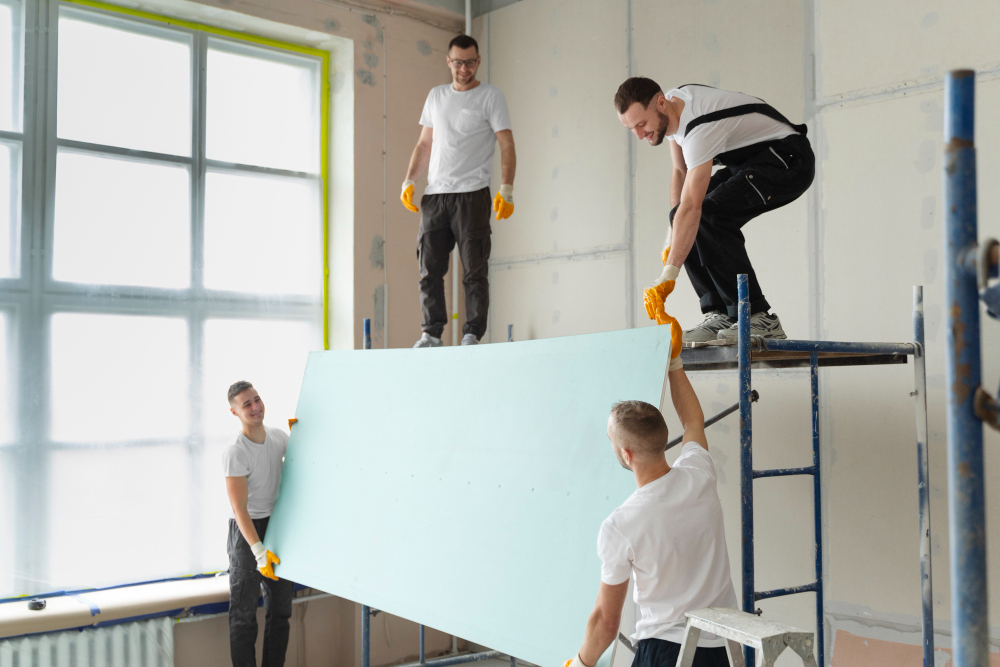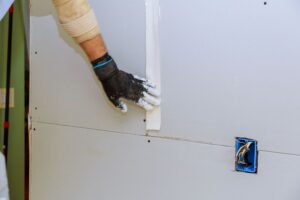Introduction
When it comes to drywall, what’s beneath the surface matters just as much as the paint on top. Sheetrock (or drywall) finishing is the crucial step that separates flawless interiors from frustrating flaws. Whether you’re remodeling a home or handling a commercial build, a poorly executed finish can quietly drain your wallet long after the project feels complete.
From repainting and sanding to structural concerns and decreased property value, the hidden costs of subpar sheetrock finishing can mount quickly. But the good news? They’re avoidable.
This guide uncovers the most common mistakes and the unseen consequences of poor finishing work—and offers professional, actionable tips to ensure your walls look sharp and last for years.
Why Sheetrock Finishing Quality Matters
Flawless Drywall Finishing in San Diego: Why It Matters
In the competitive San Diego housing market, first impressions are everything—and few details speak louder than the condition of your walls. Uneven seams, bumps, or visible shadows from poor drywall taping don’t just catch the eye—they raise red flags. These imperfections can hint at deeper quality issues, making potential buyers wary.
That’s why professional sheetrock repair in San Diego is more than just a cosmetic fix. Real estate agents consistently emphasize that smooth, well-finished walls can significantly enhance a home’s perceived value and appeal. Whether you’re preparing to sell or simply want to maintain your investment, flawless drywall sets the tone for your space and your standards.
Preventing Paint Blemishes and Surface Imperfections
Even the most expensive paint can’t cover a bad finish. Paint may highlight sanding grooves, tape lines, or pockmarks if the substrate isn’t properly smoothed. A poor finish guarantees disappointment the moment sunlight hits the wall at an angle.
Long‑Term Durability and Moisture Resistance
Quality finishing includes proper mud application and sealing—all critical in preventing moisture intrusion. In places like San Diego, coastal humidity adds pressure to get it right. Subpar sealing can lead to mildew, warping, or wall bubbling over time.
Common Sheetrock Finishing Mistakes (with Cost Impact)
Poor Joint Compound Application
Using too much or too little joint compound can cause cracking, ridging, or weak seams. Uneven mud layers may shrink unevenly, exposing tape or causing fissures that worsen with settling.
Insufficient Drying Time Before Sanding/Painting
Many rush the process—especially in humid climates. If joint compound isn’t fully dry, paint may blister or create a blotchy sheen. This leads to complete repaint jobs and doubled labor costs.
Over‑Sanding or Under‑Sanding Seams
Over-sanding thins the joint tape; under-sanding leaves visible ridges. Dust embedded in paint further amplifies the mess. These errors are easily avoidable with experience and patience.
Inadequate Corner Bead Finishing
Poor corner bead application can lead to sharp edges, dents, or cracking along high-traffic edges. Replacing corner beads after painting is costly and frustrating.
Improper Primer Use Leading to Paint Blemishes
Skipping or misusing primer often results in uneven absorption. The final paint coat may appear blotchy, emphasizing all the flaws you’re trying to hide.

The Hidden Costs Breakdown 💸
Extra Coat of Joint Compound & Labor: Re-doing layers means hours of sanding, reapplying, and waiting—all of which cost money.
Water Damage Can Ruin More Than Just Walls — It Can Ruin Your Reputation
For contractors, one poorly finished project—especially one involving improper water damage repair—can cost more than just the job. It can cost client trust, referrals, and long-term reputation. Water damage isn’t just about drying out a space; it requires precise restoration, from replacing sheetrock to ensuring seamless finishes.
For contractors, one poorly finished project—especially one involving improper water damage repair—can cost more than just the job. It can cost client trust, referrals, and long-term reputation. Water damage isn’t just about drying out a space; it requires precise restoration, from replacing sheetrock to ensuring seamless finishes.
Re‑Sanding and Repainting Cycles: Paint jobs marred by finishing issues require full sanding and repainting, often costing hundreds per room.
Compromised Insulation and Moisture Barriers: Incomplete sealing allows moisture to creep into insulation, leading to mold, odor, and energy inefficiency.
Avoid Costly Mistakes – Trust SDrywallPro
Many San Diego homeowners and contractors turn to professional drywall installation and finishing that saves money long-term.
Professional Sheetrock Finishing Tips
Choosing the Right Joint Compound
- All-Purpose: Good for initial taping and bedding seams.
- Lightweight: Ideal for final coats—easier to sand.
- Setting-Type: Fast-drying; great for time-sensitive repairs.
Layering Technique: From Taping to Final Coat
Apply at least three coats: a tape coat, a filler coat, and a finish coat. Each should feather out wider than the last for seamless blending.
Drying Times per Climate – Especially Coastal San Diego Humidity
In high humidity, drying can take up to 24 hours between coats. Use dehumidifiers or ventilation fans to accelerate curing safely.
Sanding Techniques: Sanding Blocks vs Pole Sanders
Pole sanders cover broad surfaces faster, while sanding blocks are ideal for corners and feathering. Always use fine-grit sandpaper to avoid scratching.
Clean-Up Between Coats to Avoid Dust Contamination
Dust settles into wet mud, creating bumps. Always vacuum or wipe down surfaces between coats and before priming.
Primer Selection for a Flawless Paint Finish
Use a drywall-specific primer to seal the surface evenly. This ensures consistent paint absorption and a smooth, blemish-free finish.
Quality Assurance: How Homeowners & Contractors Can Inspect Finishing
The Shadow Test: Angled Lighting Inspection
Shine a flashlight or work light across walls at a low angle. This exposes every ridge, seam, or sanding swirl that daylight might miss.
Tactile Inspection: Feeling for Bumps or Ridges
Run your hand over joints and corners. Any texture inconsistency means more sanding or an extra mud coat is needed.
Test Cuts and Repair Areas Early Rather Than Late
Identify problem spots before painting. Cutting open suspect areas for repair is far less expensive than post-paint fixes.

Pre‑Painting Checklist: Final Sweep Before Primer
Ensure all surfaces are sanded, dust-free, and visually seamless under angled lighting. Only then should you move to primer.
When to Hire Professional Drywall Installers
Complex Jobs: Multi‑Level Ceilings, Arched Openings
Architectural details demand precision that DIY often can’t provide. Curves, vaulted ceilings, and soffits require advanced taping and finishing skills.
Tight Timelines with High‑End Finish Expectations
Rushing through DIY finishing often leads to double the work. Pros get it right the first time—within schedule and budget.
Cost Comparison: DIY vs Hiring SDrywallPro
Factoring tools, time, risk of rework, and materials, hiring pros like SDrywallPro often delivers better long-term value and finish quality.
Long‑Term Maintenance to Preserve Professional Finish
Annual Visual Checks and Touch-Ups
Look for settling cracks, nail pops, or corner wear. Fix early before the damage spreads or affects multiple wall sections.
Moisture Control in Vulnerable Areas (Bathrooms, Kitchens)
Install proper exhaust fans and maintain caulking to prevent drywall swelling or mold.
Re‑Priming After Renovations or Drywall Repairs
Any patched area should be re-primed before repainting to ensure a uniform look. Skipping this step results in paint mismatch or texture contrast.
Visual Comparison Table
| Flaw | Cost Impact | Pro Tip |
| Joint cracks | +$50–$100/room | Apply thin, multiple layers and feather well |
| Paint drip marks | Full repaint required | Sand lightly and use high-quality primer |
| Visible seams | Aesthetic & value loss | Use shadow-inspection before painting |
Conclusion
Drywall finishing might seem like a small detail in a larger construction or renovation project, but getting it wrong comes with steep hidden costs. From aesthetic imperfections to long-term durability issues, poor workmanship often leads to expensive corrections.
The good news is, you don’t have to take risks.
Whether you’re a homeowner, investor, or contractor, focusing on professional-grade sheetrock finishing will protect your property’s value—and your peace of mind.
If you’re in the San Diego area and want flawless, efficient, and lasting drywall work, contact SDrywallPro today.




